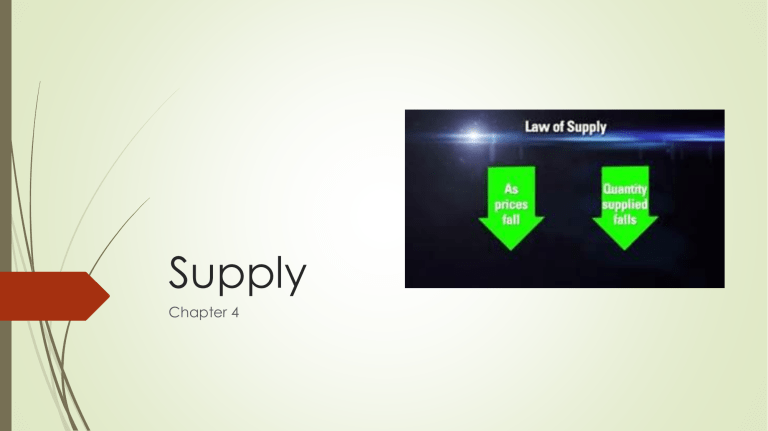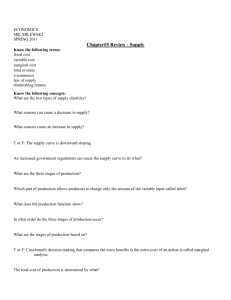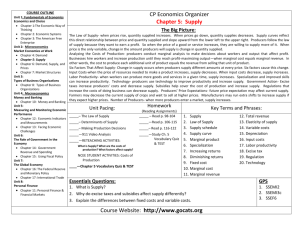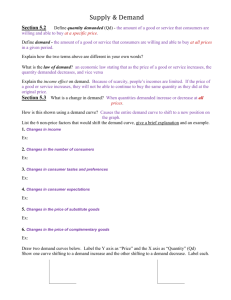File

Supply
Chapter 4
Think critically
If you earn money by working, about how much per hour do you earn?
Do you think the amount is appropriate for the work you do?
Why or why not?
Price
Serves as an incentive to producers to produce.
Would you be willing to supply your time and effort for free to a non-charity? Why not?
Supply and the Price Effect
Marginal costs of producing:
The change in costs for an additional output of production.
Also considered opportunity costs since a company will give up the opportunity to produce something else.
Higher prices for a product help to cover the higher marginal cost of producing more.
Demand vs. Supply
Demand: the quantity of a good or service
consumers are willing and able to buy at different prices at a particular time.
Supply: the quantity of a good or service
producers are willing and able to sell at different prices at a particular time.
Law of Supply
Law of Supply: a positive relationship between the quantity supplied and the price of a product.
Supply is a list of prices and the quantities that a company is willing and able to supply at each price.
Graphing Supply
A supply line slopes upward to the right to show that a company is willing and able to sell more at higher prices than at lower prices
“Supply goes to the sky.”
Price effect for supply: at higher prices producers are willing and able to provide more product since there is enough “incentive” to cover the higher marginal costs.
Board Question
What is the Law of Supply?
A positive relationship between the price of a product and the quantity supplied
Which way does the line graphing the Law of
Supply go?
Shoots to the sky
Market Supply
All producers are affected by the price effect.
Each company has different marginal costs to consider.
The supply that all producers add to the supply becomes the market supply
Market Supply: the total of all individual suppliers’ products in a market at a particular time.
Board Question
What is market supply?
the total of all individual suppliers’ products in a market at a particular time.
Price Elasticity of Supply
Elastic: change in price will cause a large change in amount supplied
Inelastic: change in price has small to no effect in amount supplied
Elasticity depends on how responsive a company can be to the change in price of a product.
Relationship between the Price Effect and a Change in Supply
When the price of a product changes, this is
NOT a change in supply.
This is a movement along the supply line: change in quantity supplied
Movement along the supply line is caused by the price effect.
Supply does not change—Law of supply states that the amount supplied would change at different prices.
Prices act as messengers: not only to consumers but also to producers.
As prices rise, producers will want to produce more.
Shifts in the Supply Curve
When supply changes:
Supply curve shifts
At every price there will be a change in the amount supplied
Caused by something OTHER THAN the price
What causes a shift in the supply curve?
Marginal costs of production changes
Lower production costs = more savings. Able to offer the product at a lower cost to consumers
A change in the number of producers
More producers = supply curve shifts to the right
Fewer producers = supply curve shifts to the left
Change in expectations
Future prices expect to be higher: shift supply curve for today to the left
Future prices expect to be lower: shift supply curve for today to the right.









